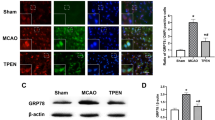Abstract
Endoplasmic reticulum (ER) stress may play a role in status epilepticus (SE). Sprague–Dawley rats were randomized into three groups: control (saline), SE (pentylenetetrazol), and dentate gyrus (DG), pretreated with 2-deoxy-d-glucose (2-DG). Expression levels of glucose-regulated protein 78 (GRP78), CCAAT/enhancer-binding protein homologous protein (CHOP), eukaryotic initiation factor 2α (eIF2α), and protein kinase RNA-like ER kinase (PERK) were determined. CHOP messenger RNA (mRNA) and protein expression levels in SE group were significantly increased as compared to the control group (P < 0.0001), and significantly decreased in DG group as compared to the SE group (P < 0.0001). Phosphorylated eIF-2α protein expression level in SE group was significantly increased as compared to the control group (P < 0.0001) and significantly decreased in DG group as compared to the SE group (P < 0.0001). GRP messenger RNA expression levels and protein levels in SE group was significantly increased as compared to the control group (P < 0.0001) and significantly decreased in DG group as compared to the SE group (P < 0.0001). Phosphorylated PERK protein expression level in SE group was significantly increased as compared to the control group (P < 0.0001), and significantly decreased in DG group as compared to the SE group (P < 0.0001) at the time of 12 and 24 h. Our results suggest that brain injury from SE might involve ER stress via the pro-apoptotic PERK–eIF2α–CHOP signaling pathway.




Similar content being viewed by others
References
Brennan GP, Jimenez-Mateos EM, McKiernan RC, Engel T, Tzivion G, Henshall DC (2013) Transgenic overexpression of 14-3-3 zeta protects hippocampus against endoplasmic reticulum stress and status epilepticus in vivo. PLoS One 8:e54491
Chen J, Qin J, Liu X et al (2008) Nitric oxide-mediated neuronal apoptosis in rats with recurrent febrile seizures through endoplasmic reticulum stress pathway. Neurosci Lett 443:134–139
Engel T, Sanz-Rodgriguez A, Jimenez-Mateos EM et al (2013) CHOP regulates the p53-MDM2 axis and is required for neuronal survival after seizures. Brain 136:577–592
Henshall DC, Murphy BM (2008) Modulators of neuronal cell death in epilepsy. Curr Opin Pharmacol 8:75–81
Lado FA, Sperber EF, Moshe SL (2001) Anticonvulsant efficacy of gabapentin on kindling in the immature brain. Epilepsia 42:458–463
Little E, Tocco G, Baudry M, Lee AS, Schreiber SS (1996) Induction of glucose-regulated protein (glucose-regulated protein 78/BiP and glucose-regulated protein 94) and heat shock protein 70 transcripts in the immature rat brain following status epilepticus. Neuroscience 75:209–219
Liu GL, Wang KY, Guo H, Zhao SJ, Shen Y, Zhao YB (2013) Inositol-requiring protein 1alpha signaling pathway is activated in the temporal cortex of patients with mesial temporal lobe epilepsy. Neurol Sci 34:357–364
Paschen W (2004) Endoplasmic reticulum dysfunction in brain pathology: critical role of protein synthesis. Curr Neurovasc Res 1:173–181
Sokka AL, Putkonen N, Mudo G et al (2007) Endoplasmic reticulum stress inhibition protects against excitotoxic neuronal injury in the rat brain. J Neurosci 27:901–908
Stafstrom CE, Roopra A, Sutula TP (2008) Seizure suppression via glycolysis inhibition with 2-deoxy-d-glucose (2DG). Epilepsia 49(Suppl 8):97–100
Stafstrom CE, Ockuly JC, Murphree L, Valley MT, Roopra A, Sutula TP (2009) Anticonvulsant and antiepileptic actions of 2-deoxy-d-glucose in epilepsy models. Ann Neurol 65:435–447
Torres-Peraza JF, Engel T, Martin-Ibanez R et al (2013) Protective neuronal induction of ATF5 in endoplasmic reticulum stress induced by status epilepticus. Brain 136:1161–1176
Yamamoto A, Murphy N, Schindler CK et al (2006) Endoplasmic reticulum stress and apoptosis signaling in human temporal lobe epilepsy. J Neuropathol Exp Neurol 65:217–225
Acknowledgments
This study was supported by Key Project supported by Medical Science and Technology Development Foundation, Nanjing Department of Health (ZKX10024).
Conflict of interest
None
Author information
Authors and Affiliations
Corresponding author
Rights and permissions
About this article
Cite this article
Chen, J., Zheng, G., Guo, H. et al. Role of Endoplasmic Reticulum Stress via the PERK Signaling Pathway in Brain Injury from Status Epilepticus. J Mol Neurosci 53, 677–683 (2014). https://doi.org/10.1007/s12031-014-0236-4
Received:
Accepted:
Published:
Issue Date:
DOI: https://doi.org/10.1007/s12031-014-0236-4




